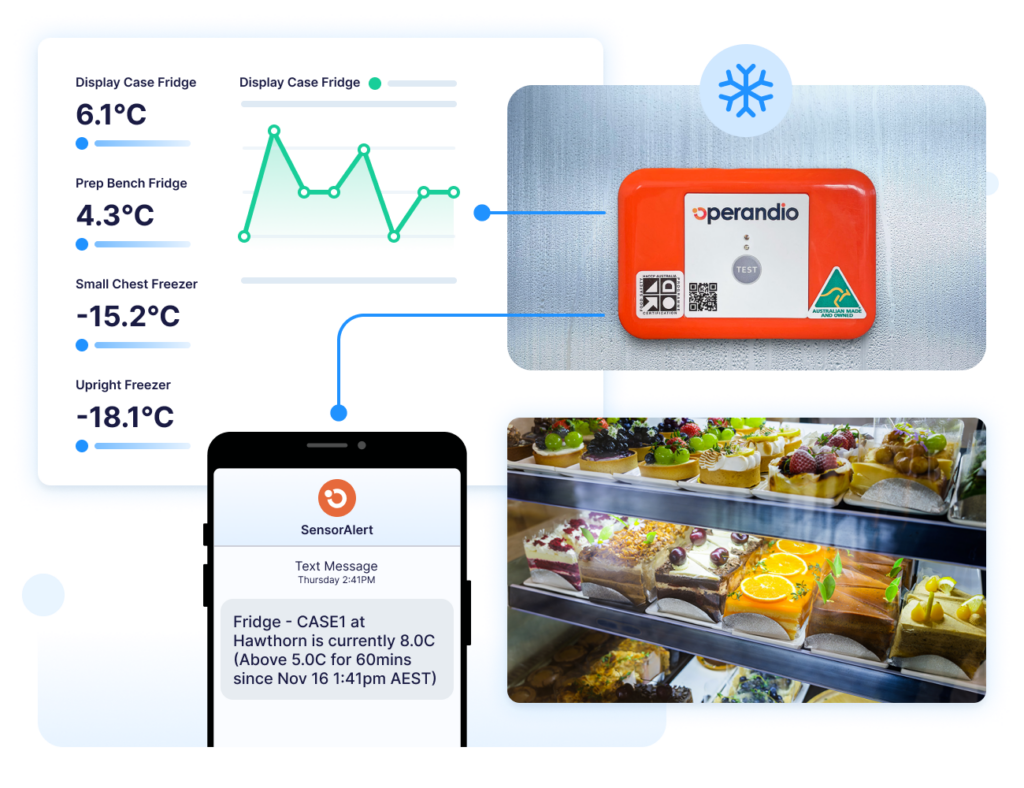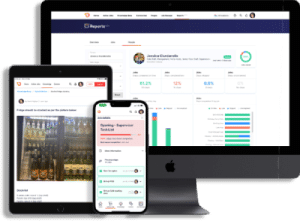Improve your kitchen temperature monitoring systems
Has there ever been a time when you or your chef went to use an ingredient and realized it’s off? If you have, you know how frustrating this can be, not to mention wasteful. Usually, the culprit is a malfunctioning temperature monitoring system, something that’s equally frustrating.
We’re here to say this can be a problem of the past! Easily implement steps and processes to help prevent spoilage thanks to proper refrigeration monitoring.
This article details the value of efficiency tools like daily temperature logs, the pitfalls of traditional recording methods, maintenance checklists, and ways to improve staff accountability. All of which can help keep your kitchen humming along.

Why are daily temperature logs essential?
They say knowledge is power; this couldn’t be truer in hospitality. Knowing how your kitchen equipment performs daily can help you notice issues or problems before they become too serious. Daily temperature logs are designed for this purpose. Every day, you or your staff record the temperature of your fridges and food preparation areas, review these numbers, cross-check with previous days for any discrepancies, and address issues as they arise.
It’s a handy tool, but it’s also a versatile one. Daily temperature logs can help your kitchen:
- monitor product quality
- maintain regulatory compliance, i.e. health code standards
- avoid spoilage
- safeguard customer safety
- mitigate health risks.
A daily temperature log is a great tool to help you react to a temperature-related problem. However, often the best solution to a problem is prevention. This is where a kitchen maintenance checklist can help you notice an issue before it becomes too serious.
Kitchen maintenance checklist for temperature management
Kitchen maintenance checklists, along with daily temperature logs, are a great tool to observe any climate-related issues in your venue. This useful resource allows you to record and cross-check what’s working well and what isn’t. Dedicating a few minutes every day to complete these checks could save you from having unnecessary spoilage.
Daily checks
Sensor functionality
- Check all sensors are operational.
- Make sure sensors are securely in place.
Alert system
- Test the alert system by triggering a simulated temperature glitch.
- Confirm you receive alerts promptly. If not, get the sensors repaired.
Weekly checks
Battery status
- Check the battery status of each sensor.
- Replace batteries as needed to maintain uninterrupted monitoring.
Temperature calibration
- Perform a spot-check with an external thermometer to verify the accuracy of sensor readings.
- Adjust sensors if necessary to maintain precision.
Review your logs
- Review and organize all temperature-related logs.
- Address any gaps or inconsistencies in records.
Kitchen checklist for restaurant temperature management
A fridge is an important part of the kitchen, but it’s not the only place where your food is stored. There are numerous areas within a busy kitchen where inconsistencies in temperature can create big issues. Checking these areas daily and weekly can make a huge difference, so make it a part of your or your kitchen staff’s routine.
Daily checks – areas of note
Freezer units
- Monitor freezer temperatures to guarantee goods are staying frozen.
- Confirm your freezer doors are sealing properly to prevent temperature leaks.
Food preparation areas
- Check the temperature of food preparation surfaces and ensure they comply with safety standards.
- Verify the hot and cold holding areas maintain the required temperatures.
What you should check during operational hours
Cooking equipment
- Regularly monitor the temperature of ovens, grills, and other cooking equipment and make sure they’re accurate.
- Adjust temperature settings as needed to accommodate varying menu items.
Food storage rotation
- Implement a system for rotating perishable items based on their expiration dates. Whenever a new order comes in, move the older items to the front and the newer ones to the back of your storage areas.
- Regularly check and record the temperatures of stored ingredients, making sure they’re in suitable conditions.
Weekly checks
Deep cleaning schedule
- Establish a schedule for deep cleaning kitchen equipment, including temperature sensors.
- Pay attention to the sensors. Make sure they’re free from any debris or build-up that could affect readings.
Staff training
- Conduct regular training sessions to educate kitchen staff on the importance of temperature management.
- Delegate tasks that each team member is responsible for.
Staff accountability in temperature monitoring
You can’t be everywhere at once. This is why training your team to do their best is so important. Firstly, run training sessions for your team that simplify the correct use of temperature monitoring equipment. Then, delegate specific responsibilities to each team member involved. Highlight the importance of their role in upholding food safety standards.
Once you have defined these responsibilities, make an effort to celebrate a job well done. Introduce a rewards system to celebrate and motivate consistent performance. Conduct regular workplace communication with your team members. This communication is a great way to give constructive feedback and praise.
Additionally, empower your team to take an active role in decision-making regarding temperature control. If they notice a faulty fridge, they should feel confident enough to bring it up with a manager as soon as possible.
Implementing efficient temperature monitoring systems
If all of this seems like a lot, don’t worry. To help ease the burden, install a modern temperature monitoring system at your venue. One that takes advantage of innovative technology and offers real-time insights. Because traditional methods, like a tattered logbook and old thermometer, is not always efficient.
The power of wireless sensor technology
Wireless sensors strategically placed throughout your business give you the power of real-time temperature monitoring. These sensors, easily installed within minutes, observe your temperature-sensitive assets, offering a level of accuracy and reliability that traditional methods struggle to match.
Real-time monitoring
The continuous monitoring ensures businesses have immediate access to crucial data, allowing for proactive decision-making. For example, if one of your fridges is rapidly losing temperature, move perishables into another cool area and call a repairer to fix the issue.
Instant SMS alerts
You and your venue’s staff receive immediate notifications when a temperature anomaly occurs, allowing them to address issues before they escalate.
Operandio simplifies temperature monitoring
Operandio’s innovative system revolutionizes temperature monitoring in the hospitality industry, delivering benefits like enhanced food safety, operational efficiency, and cost reduction.
Embrace a new era of precision and efficiency in temperature monitoring – book a free demo today.
Try Operandio for free
Get started in less than 2 minutes.
By signing up, you accept the Subscription Agreement and Privacy Policy.
